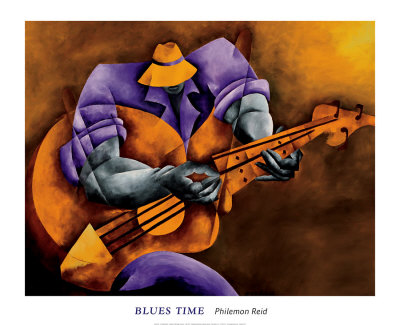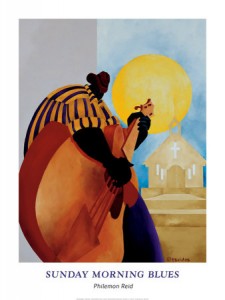
Long before DIY became a Portland catch-phrase, Philemon Timothy Reid was quietly doing it himself. A self-taught artist, Reid spent a lifetime doing the things you need to do. Born in Eatonton, Georgia, he spent nine years in the service, went to night college, and worked many years for the Bonneville Power Administration. He settled in Vancouver. He raised a family.
 And through it all he did the thing he loved to do, which was to paint and sculpt images of the African American musicians who played the blues and jazz. He often listened to Coltrane or Miles or Ella while he was making his own art.
And through it all he did the thing he loved to do, which was to paint and sculpt images of the African American musicians who played the blues and jazz. He often listened to Coltrane or Miles or Ella while he was making his own art.
“Phil” Reid died June 9 of pancreatic cancer, and while for many people who knew him that was a very personal loss, for me he was a missed journalistic opportunity. I never met him, and for a long time I meant to. I just didn’t get around to it.
There are a million stories out there, and every writer knows that for every one you manage to tell, a hundred get away. Phil Reid’s story was one of my many hundred untold tales.
As far as I know Reid wasn’t much aligned with any particular group of Portland artists. He wasn’t part of any art-school crowd. He wasn’t avant-garde. Technically, there wasn’t much novel in what he did: He adapted familiar Cubist techniques to his own subject matter, although he maintained more representational roots than Picasso, whom he cited as a major influence: I think that might have had to do with the African American tradition of storytelling and its superreality, although I don’t know for sure. He had a loyal, even enthusiastic following, but for the most part it didn’t seem to include the people who haunt museums and galleries.
Yet every time I saw his work it made me stop and think. And usually smile, because invariably there was a gusto, a joy, in the images he made. And I’d think, this is an interesting guy. I should look into this. His sense of men and women at work, immersed in the pleasures and tribulations of their trade, harked back to the social realists of the 1930s.
The exaggerations of his shapes — great guitars that swoop across the canvas, eating up half of the picture; strong chord-plucking fingers that seem like limbs on a mighty Sequoia tree — suggest the tall tale: John Henry; the nameless narrator of St. James Infirmary Blues.
And his colors! Every time I saw them I thought about the pleasure that so many black people take in dressing vibrantly, in reveling in the brightest of rainbows. Remember how, in the movie Watermelon Man, Godfrey Cambridge dressed brighter and sharper the more he became immersed in his black identity?
Unfortunately, anything I say about Philemon Reid is guesswork, the flawed and incomplete deductions of long-range, occasional observation. I’m sorry about that. This is a story, I suspect, worth much more than I can tell.